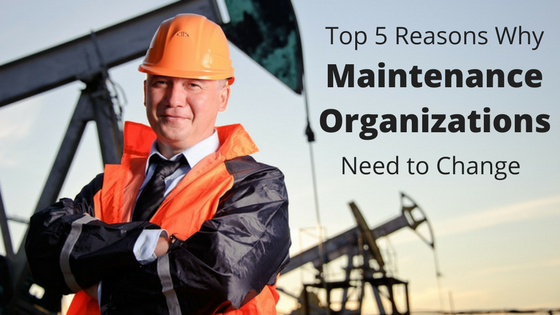Maintenance is a serious business, especially for asset-intensive companies. As an example, without stringent maintenance standards, and regulatory guidelines, the rate of industrial accidents would surely rise. Without properly functioning equipment, production grinds to a staggering halt. In large maintenance organizations, that can translate to millions of dollars in lost income.
Maintenance organizations spend millions of dollars each year on their EAM/CMMS system and maintaining the equipment that is the lifeblood of their business. Anything affecting the ability of that equipment to perform at peak performance wreaks havoc on the company’s bottom line. Maintenance costs a lot of money. Not maintaining equipment properly costs even more.
Whether you like it or not, the maintenance organizations are being forced to change. The maintenance workforce is aging and maintenance expertise is becoming harder and harder to find, and more expensive to develop. Also, the pressure is on to continually work smarter, be more productive, cut costs, and increase production. This is no easy task when it comes to maintenance, but there are solutions available to help. You can no longer rely on spreadsheets for accurate asset information and upkeep. Ultimately, change is inevitable and constant, and should be embraced in order to improve.
Over the years, we’ve had the opportunity to talk to many asset-intensive companies about the challenges that their maintenance organizations are facing. Let’s look at 5 of the top challenges realized and the reasons why current asset and maintenance practices need to change.
1. Achieving High Quality Maintenance Data
The data loaded into an EAM system needs to be accurate. Maintenance organizations spend so much time (and money) collating data into spreadsheets, and then finding that the data isn’t right, or isn’t useful. The process is inherently flawed. When you are going into operations, it’s far too late to discover that your maintenance data is incomplete. Ideally, you want to know your data is of high quality before it is loaded into your EAM system. You need a way to determine the quality of the data, and identify any gaps as the data is being built.
2. Monitoring Contractors & Consultants
Because much of the asset and maintenance data that is ultimately loaded into an EAM system originates with a contractor or a consultant, many companies are at the mercy of these people during a data build or repair project. They have no way to measure the quality of the data that is delivered. They cannot tell if it is complete or accurate. Companies need a way to quickly assess the data, ideally on an ongoing basis as it is being built by contractors. When the data is inaccurate, or has gaps, wouldn’t it be great to be able to push back to the contractor immediately and have it rectified right away?
3. Enabling Data Reuse
Companies that are expanding are looking for smarter ways to do so, to lower the costs of a capital project. They need an enterprise library of common maintenance data that can be reused wherever a particular asset is used. Why reinvent the wheel every time you roll out a new facility? Companies want to make sure it is easy for people within the organization to have access to and share information that is common to multiple projects.
4. Implementing Performance Standards
Asset-intensive organizations need a way to ensure that corporate performance standards are properly implemented in their EAM systems. Because EAM solutions are designed to be transactional systems that generate work orders and facilitate maintenance operations, there is no easy way to determine if the maintenance plans for an asset conform to corporate performance standards. There is no way in an EAM system to view equipment with no associated performance standards, or to report on compliance with these standards.
5. Easily Visualizing & Editing EAM/CMMS Data
Let’s face it: changing data in an EAM system is not easy. If a maintenance worker discovers that information is wrong in the system, does he have the knowhow or permissions to update it? Not likely. Companies need to be able to visually connect spare parts to the assets they belong to so the maintenance worker can easily find the correct part information, and update it as required. Companies want to be able to copy and paste data from one asset to another that is similar or the same. They should be able to drag and drop assets into a hierarchy.
Final Remarks
It’s really quite shocking what you can’t do or see in an EAM system, isn’t it? And yet, most maintenance organizations recognize the importance of their data enough to try and get into an EAM system. But they seem to be at a loss to find a way to use that data to their advantage.
It’s time to bring asset and maintenance data processes and techniques into the 21st century. It’s time to let the software do the work. It’s time to make your data work for you, instead of the other way around!
Resources Available to Help Maintenance Organizations
Whitepaper | Realizing the Benefits and Importance of an Effective Data Cleansing Project
Discover how a reliable cleansing solution can fix problems and save valuable time and money for your company.
Webinar | Tackling the Big Three Maintenance Master Data Quality Issues
Greg Dee, President at HubHead Corp., sits down with members of VIZIYA to discuss practical solutions to tackle your maintenance master data quality issues. The three big culprits: asset hierarchy, task lists, and work order types.
Share this article

